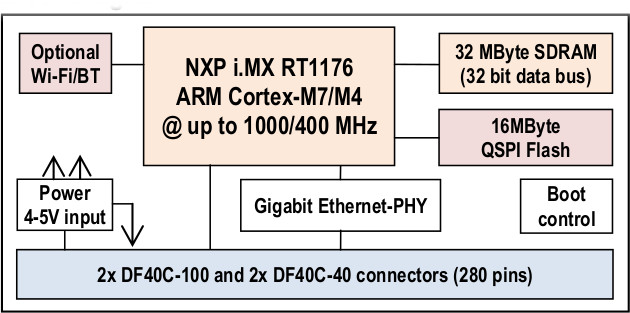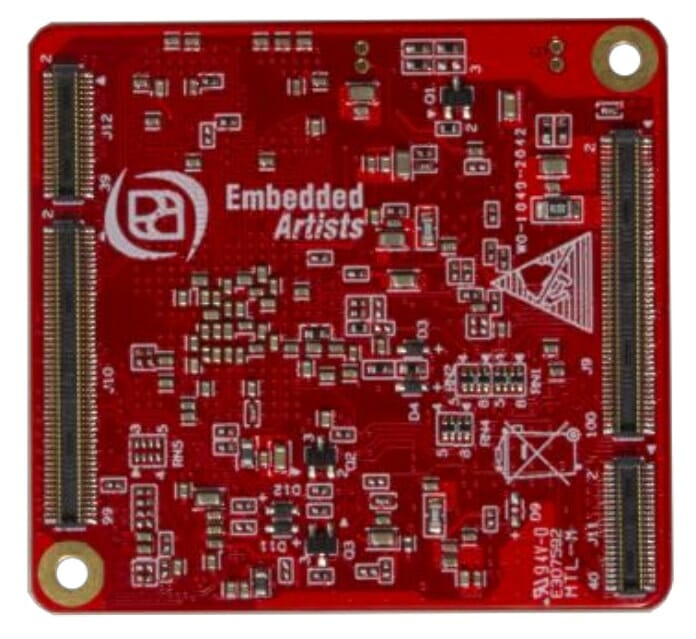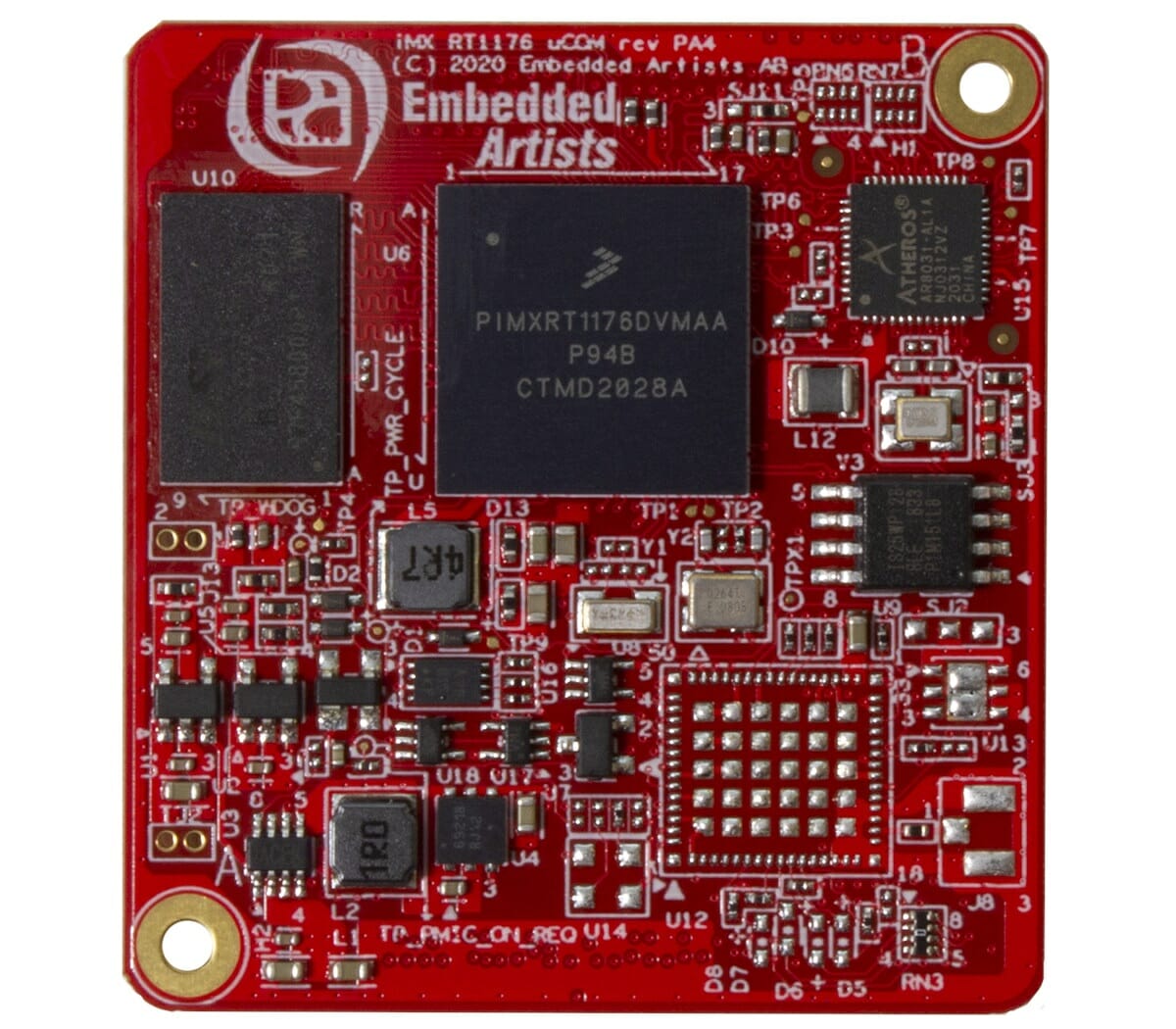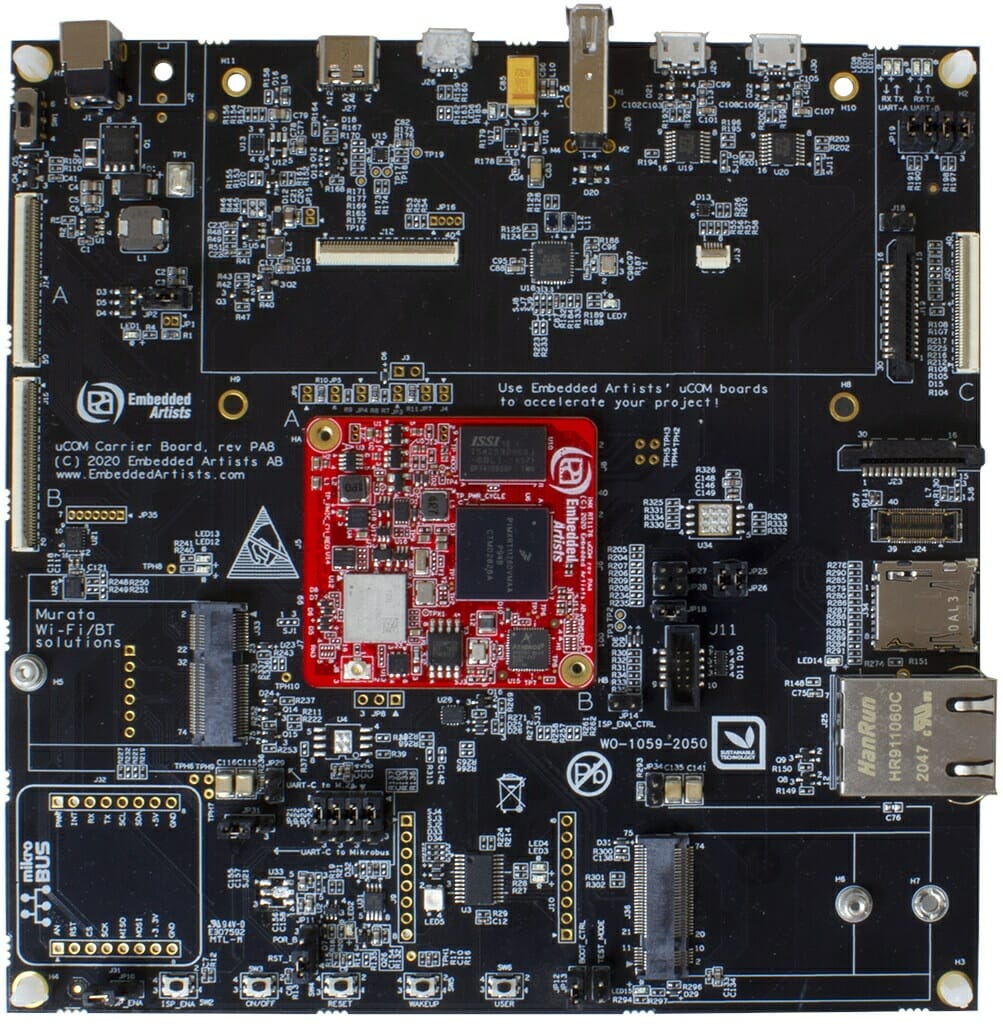Microcontrollers used to be those cute little chips clocked at 8 MHz, but it’s now common to have MCUs clocked at one or two hundred Megahertz, and with Cortex-M7 cores, several hundred Megahertz is now possible, and NXP even pushed the limit to one Gigahertz with their i.MX RT1170 series of Cortex-M7/M4 Crossover MCUs announced over a year ago.
Embedded Artists has now made a computer-on-module and a corresponding devkit based on NXP i.MX 1176 Crossover MCU clocked at one Gigahertz. iMX RT1176 uCOM MCU module delivers up to 6468 Coremarks, comes with up to 32MB SDRAM, 16MB QSPI flash, optional WiFi and Bluetooth, and various peripherals in a tiny 45x42mm form factor.
iMX RT1176 uCOM module
- SoC – NXP i.MX RT1176 processor with Cortex-M7 core up to 1 GHz/800MHz (Commercial vs industrial), Cortex-M4 core up to 400/200 MHz, 2MB internal SRAM, 2D GPU with OpenVG 1.1 support and 2D accelerator (PXP); note: no VPU for video decoding/encoding
- System Memory – 32 MB SDRAM
- Storage – 16 MB QSPI flash
- On-module connectivity – 1x on-board Gigabit Ethernet PHY, optional Murata Type 1ZM dual-band 802.11b/g/n/ac WiFi 5 and Bluetooth 5.1 module based on NXP 88W8987
- 2x DF40C-100 and 2x DF40C-40 board-to-board connectors with
- Display Interface – MIPI-DSI up to 1080p30, Parallel RGB up to 1280×800 at 60Hz
- Camera interface – MIPI CSI, Parallel CSI
- Audio – 5x SAI, DMIC, SPDIF
- Ethernet – 1x Gigabit Ethernet, 1x 10/100M Ethernet (required additional PHY on carrier board)
- USB – 2x HS USB 2.0 OTG
- 2 blocks of FlexIO
- Serial – 12x UART, 3x CAN
- 6x I2C, 6x SPI, 4x PWM
- 12-bit ADC/DAC
- 2x SD3.0
- Supply Voltage – 4 to 5.0V input
- Dimensions – 45 x 42 mm (EAuCOM form factor)
- Temperature Range – 0 to 70°C or -40 to 85°C


Anders Rosvall, CTO at Embedded Artists AB, explains the i.MX RT1176 uCOM board “enables customers to move up to application-level performance without having to move to the Linux world”, and provides an update from the company’s iMX RT1064 uCOM with double the SDRAM, MIPI-DSI interface, and a 2D graphics engine. In case you wonder why a company would not want to move their application to a Linux platform, reasons include code reuse, faster real-time responsiveness, and lower power consumption.
uCOM i.MX RT1176 Developer’s Kit
Embedded Artists also provides a developer’s kit for evaluation and early software development that include uCOM carrier board with the following key features:
- DF40C 100/40-pos connectors for uCOM modules
- Storage – MicroSD card socket, pads for mounting QSPI flash memories
- Display Interfaces
- MIPI-DSI dual connectors
- Parallel RGB with backlight control. Note: Feature not accessible with standard mounting option for the iMX RT1176 uCOM board.
- Adapter for MIPI-DSI to HDMI (but the driver is not yet available).
- Camera interface – MIPI-CSI, dual connectors
- Connectivity – Gigabit Ethernet RJ45 connector; adapter for second 10/100 Mbps Ethernet PHY
- USB – 1x USB OTG interface, 1x USB host interface
- Expansion
- M.2 E-key connector with SDIO, PCIe and USB interfaces connected for Wi-Fi/BT M.2 modules
- M.2 B-key connector with PCIe, USB and SIM card holder interfaces connected
- Mikrobus interface connector for Click boards
- Expansion connectors for accessing uCOM board signals
- I2C GPIOs and I2C PWMs expanders
- Debugging
- Dual UART-to-USB FTDI bridge for console connections
- 2×5 pos 50 mil pitch Cortex debug connector
- Misc – External VBAT power input for RTC on-module; On/Off, Reset, ISP Enable, Wakeup and user pushbuttons; RGB LED; LEDs
- Power Supply
- 12V (+-30%) with reverse polarity protection
- Current measurement possibilities in supply voltages
- 5V/5A DC/DC supply to uCOM
- Dimensions – 152 x 152 mm with 5x 4.3mm holes for mounting and grounding
Availability an pricing
The i.MX RT1176 Developer’s Kit is available now for 199 Euros, while the i.MX RT1176 uCOM module starts at 35 Euros, and there are multiple mounting options offered by the company. For more details, you can read the press release, the product pages for the module and the devkit, with the latter available via online orders.

Jean-Luc started CNX Software in 2010 as a part-time endeavor, before quitting his job as a software engineering manager, and starting to write daily news, and reviews full time later in 2011.
Support CNX Software! Donate via cryptocurrencies, become a Patron on Patreon, or purchase goods on Amazon or Aliexpress






